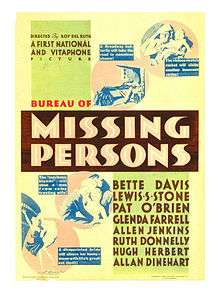Bureau of Missing Persons
| Bureau of Missing Persons | |
|---|---|
 Theatrical release poster | |
| Directed by | Roy Del Ruth |
| Produced by | Henry Blanke |
| Screenplay by | Robert Presnell, Sr. |
| Based on |
Missing Men by John H. Ayers and Carol Bird[1] |
| Starring | |
| Music by | Bernhard Kaun |
| Cinematography | Barney McGill |
Release dates |
|
Running time | 76 minutes |
| Country | United States |
| Language | English |
Bureau of Missing Persons is a 1933 American pre-Code drama film with comic overtones directed by Roy Del Ruth. The screenplay by Robert Presnell is based on the book "Missing Men" by former New York City police captain John H. Ayers and Carol Bird.
Plot
Amid vignettes involving a philandering husband who fakes amnesia, a child prodigy who yearns to live a normal life, an aging bachelor whose housekeeper has disappeared, and an old lady whose daughter has run away, the primary plot line focuses on brash detective Butch Saunders, who is assigned to find missing Chicago banker Therme Roberts. Butch makes no secret that he is attracted to the man's wife, Norma, even though they are both married. When his superior, Captain Webb, tells him she really is Norma Phillips and the man she claims is missing is not her husband but the person she has been accused of murdering, he does not want to believe it. Norma fakes her suicide by drowning and disappears, but cannot resist returning when Butch stages her funeral in the hope she will surface. Not only she but the missing Roberts, as well, turn up at the services. Norma tells Butch she once was Roberts' secretary, and he killed his mentally disturbed twin brother and assumed his identity in order to avoid embezzlement charges. Roberts denies her accusations, but Webb tricks him into admitting his guilt. Norma is cleared and, when Butch learns his wife Belle never divorced her first husband, the two are free to be together.
Cast
- Bette Davis as Norma Roberts
- Lewis Stone as Captain Webb
- Pat O'Brien as Butch Saunders
- Glenda Farrell as Belle Saunders
- Allen Jenkins as Joe Musik
- Ruth Donnelly as Gwendolyn Harris
- Hugh Herbert as Hank Slade
- Alan Dinehart as Therme Roberts
- Marjorie Gateson as Mrs. Paul
Production
The film's working title was Missing Persons, and Warren William was originally slated to star.[2] Instead it became the second on-screen pairing of Davis and O'Brien, both under contract to Warner Bros., who had appeared Hell's House the previous year.
Release
Bureau of Missing Persons premiered at the Strand Theatre in New York on September 7, 1933. As a promotion, Warner Bros. promised in advertisements to pay $10,000 to Manhattan's missing Judge Joseph Force Crater if he turned himself in to the Bureau during the picture's engagement at the Strand.[3] The film went into general release on September 16.[2]
In 1936, the picture was reissued with the opening credits reconfigured to give top billing to Davis, who was by then the studio's leading female star.[4]
Critical reception
Mordaunt Hall, critic for the New York Times, gave the film a generally positive notice and remarked on the fact-based elements: "It is quite obvious that fact is the basis of many of the incidents and if several of the characters are too rowdy at times to be lifelike, it does not detract from the general interest of the production."[5] Time said, "this is as engrossing as the normal detective cinema, but what gives Bureau of Missing Persons substance and makes it interesting journalism as well as adequate fiction are convincing shots of how a Missing Persons Bureau works".[6]
Variety called it "pretty fair entertainment ... steered clear of over sombreness or becoming too morbid" and added, "Just when it threatens to become banal, excellent trouping and some inspired dialoguing snap it back into proper gait."[7] The Film Daily review said it was "marred by mixed incidents and hoke Hollywood ending".[8]
Time Out London says, "With Del Ruth directing at screwball pace, things sometimes get a little too jokey; but at its best, in noting the obsessive quirks developed by officers, it has some claim to be considered an ancestor of Hill Street Blues."[9] TV Guide describes it as an "amusing mystery film that is genuinely complex and intriguing, though it does take some slapstick turns. Davis fans will be disappointed as her headlining part is relatively small."[10]
References
- ↑ Goble, Alan (1999). The Complete Index to Literary Sources in Film. Walter de Gruyter. p. 19. ISBN 978-3-11-095194-3.
- 1 2 3 "Bureau of Missing Persons". Catalog of Feature Films. American Film Institute. Retrieved 2015-11-19.
- ↑ Daly, Phil M. (September 6, 1933). "Along the Rialto". The Film Daily. 63 (56): 6 – via Internet Archive.
- ↑ Miller, John M. "Bureau of Missing Persons". Turner Classic Movies.
- ↑ Hall, Mordaunt (September 9, 1933). "Lewis Stone, Pat O'Brien and Bette Davis in "Bureau of Missing Persons" at the Strand". New York Times. Retrieved 2015-11-19.
- ↑ "Bureau of Missing Persons". Time. September 18, 1933. (subscription required (help)).
- ↑ Green, Abel (September 12, 1933). "Missing Persons". Film Reviews. Variety. 112 (1): 17 – via Internet Archive.
- ↑ "Bureau of Missing Persons". The Film Daily. 63 (54): 3. September 2, 1933 – via Internet Archive.
- ↑ Time Out London review Archived June 6, 2011, at the Wayback Machine.
- ↑ TV Guide review
External links
- Bureau of Missing Persons at the Internet Movie Database
- Bureau of Missing Persons at the TCM Movie Database